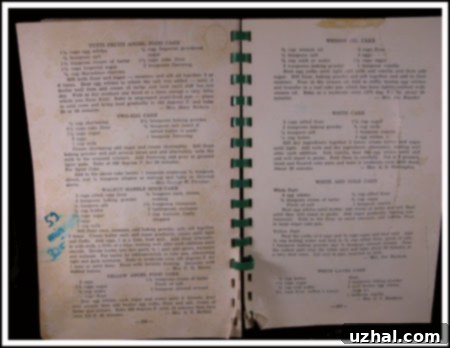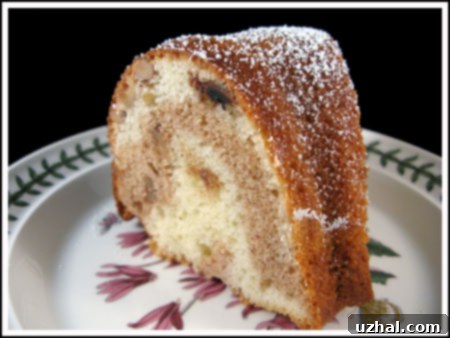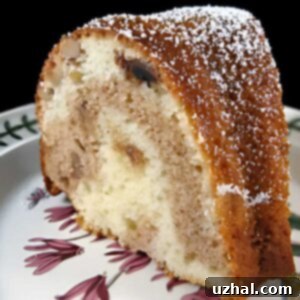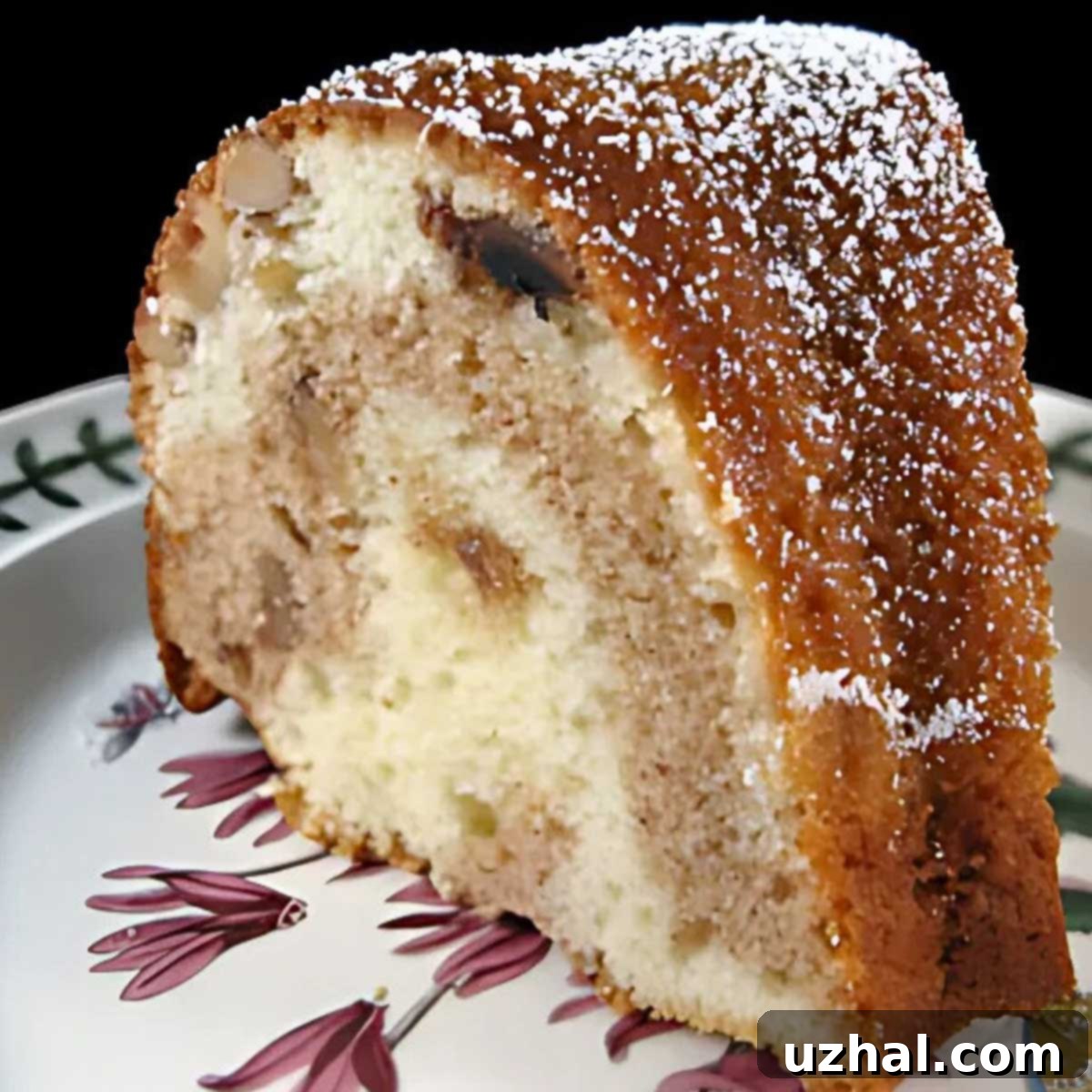Discovering a Classic: The Timeless Walnut Marble Spice Bundt Cake from an Heirloom Methodist Cookbook
There’s a unique joy in culinary exploration, especially when it involves dusting off old cookbooks and letting serendipity guide your next baking adventure. Recently, facing that delightful dilemma of “what to bake today,” I found myself surrounded by stacks of vintage culinary treasures. My fingers traced the worn spines and dog-eared pages, searching for a spark of inspiration. The true gem that caught my eye, a recipe source that transcended the ordinary, was a humble yet intriguing Marble Spice Cake from The Methodist Cookbook. This particular edition, hailing from St. John’s Methodist in Richmond, Texas, held an “unknown” publication date, adding to its mysterious charm. What makes these old community cookbooks so captivating is their authenticity – everything is from scratch, and some recipes even embrace a delightful ambiguity, with instructions like “add enough flour to reach cookie dough consistency” or “bake in a moderate oven” without a precise temperature. It’s a testament to a time when baking was more intuitive, passed down through generations of experience rather than strict scientific measurement.

The Secret to a Perfect Crumb: Why You Can’t Skip the Sift in Vintage Baking
In a world of imprecise measurements within this charming old cookbook, what truly drew me to Mrs. C.D. Myers’ Walnut Marble Spice Cake recipe was its refreshing clarity. Amidst the charmingly vague instructions typical of its era, Mrs. Myers was meticulous enough to specify an oven temperature of 350°F and, crucially, to include precise directions on the number of times to sift the flour. This attention to detail immediately signaled a recipe worth trusting, and it paid off beautifully. The resulting cake was not just delicious, but boasted an astonishingly tight-crumbed texture, a characteristic I largely attribute to my diligent adherence to her sifting instructions. Sifting flour is more than just removing lumps; it’s a vital step that aerates the flour, making it lighter and easier to incorporate into the batter. This aeration contributes to a more tender and delicate cake crumb. Furthermore, using cake flour, with its lower protein content, combined with careful weighing, enhanced this effect. The delicate nature of cake flour, when properly sifted, creates a structure that can absorb moisture more evenly, preventing a dense or heavy result. This seemingly simple step is a foundational principle in achieving baking perfection, especially with classic recipes like this one.

The intriguing nature of this cake prompted me to delve into some online research, hoping to uncover similar recipes or trace its lineage. The closest match I found was a “Marble Spice Picnic Cake,” which shared many similarities with my treasured Methodist recipe but was scaled down and designed for a different pan size. This suggests a common culinary thread woven through different community and home kitchens of the past. Interestingly, this recipe’s generous proportions suggest it was intended for larger gatherings, perfect for a church potluck or family picnic. While my current recipe calls for a 10-inch Bundt pan, you can easily halve the ingredients to bake a smaller version in a 6-cup Bundt pan, though it will yield a more petite cake. The adaptability of these classic recipes is part of their enduring appeal, allowing home bakers to adjust for different occasions and serving sizes.
Another fascinating clue to the cake’s potential origins came from renowned baker Nick Malgieri. He recounted finding his marble spice Bundt cake recipe in an old cake flour booklet from the 1930s. Although he made significant adjustments, transforming it into a distinctly different cake, I can’t help but wonder if the original recipe from that vintage cake flour booklet might have been a close relative to, or even a precursor of, this very Methodist Walnut Marble Spice Cake. This theory speaks to the way recipes traveled and evolved through printed materials, community sharing, and adaptations by home bakers, becoming beloved staples in countless households. Such historical connections underscore the rich tapestry of culinary heritage, where a simple cake can tell a story spanning decades.
Essential Baking Tips for Your Walnut Marble Spice Cake Success
Achieving the perfect Walnut Marble Spice Cake, with its tender crumb and rich flavor, hinges on a few crucial baking principles. While this is a truly wonderful vintage cake, precision, especially with flour measurement, is paramount. Here are some detailed tips to ensure your baking success:
- Accurate Flour Measurement is Key: The recipe calls for 3 cups of *sifted cake flour*. It’s vital to understand that 3 cups of sifted cake flour weighs considerably less than 3 cups of unsifted all-purpose flour. Cake flour is lighter and has a lower protein content, contributing to a softer, more delicate crumb. If you opt to use all-purpose flour, you must adjust the measurement to prevent a dense, dry cake. For all-purpose flour, aim for approximately 285 grams or about 2 ⅓ cups (spooned lightly into the measuring cup and leveled, not scooped). Always sift your flour at least once, preferably twice as the recipe suggests, even if using cake flour, to ensure aeration and even distribution of dry ingredients.
- Butter Type and Salt Adjustment: The recipe specifies salted butter. If you prefer or only have unsalted butter on hand, remember to bump up the salt in the recipe from ½ teaspoon to 1 teaspoon. This ensures the flavor balance isn’t compromised. Bringing butter to room temperature (softened but not melted) is also crucial for proper creaming with sugar, which incorporates air into the batter for a light texture.
- The Importance of Whole Milk: For the best results, use whole milk. Its higher fat content adds richness and moisture to the cake, contributing to that desirable tender crumb. While lower-fat milk can be substituted, it may result in a slightly less moist cake.
- Room Temperature Ingredients: This is a golden rule in baking, especially for cakes. Ensure your butter, eggs, and milk are all at room temperature before you begin. Room temperature ingredients emulsify more effectively, creating a smooth, homogenous batter that traps air efficiently, leading to a lighter and more evenly textured cake. Cold ingredients can cause the batter to curdle and prevent proper mixing.
- Finely Chopped Walnuts: The recipe calls for 1 cup of finely chopped walnuts. Finely chopping the nuts ensures they are evenly distributed throughout the cake and prevents them from sinking to the bottom during baking. It also allows the walnut flavor and texture to be integrated subtly into every bite without overwhelming the delicate spice notes.
- Perfect Pan Preparation: For a Bundt cake, proper pan preparation is essential for a clean release. Grease your 10-inch Bundt pan generously with butter or a non-stick baking spray, ensuring every crevice is coated. Then, flour the pan, tapping out any excess. If using a silicone Bundt pan, a light slick of oil is usually sufficient, as silicone generally has natural non-stick properties.
By following these detailed tips, you’re not just baking a cake; you’re honoring a timeless recipe and ensuring a delicious outcome every time. This Walnut Marble Spice Cake is more than just a dessert; it’s a piece of culinary history, a comforting treat perfect for any occasion.
- Buttermilk Marble Cake Baked in a 9×13 inch Pan
- Marbled Peanut Butter Brownies
- Marbled White Chocolate Cheesecake
- Frosted Fudge Brownies
- Marbled Cream Cheese Brownies
Recipe

Classic Walnut Marble Spice Cake (from a Vintage Methodist Cookbook)
Anna
Pin Recipe
Ingredients
- 3 cups sifted cake flour (285 grams, for all-purpose use 2 ⅓ cups or 285g)
- 4 teaspoons baking powder
- ½ teaspoon salt (use 1 tsp if using unsalted butter)
- 1 ½ sticks salted butter, softened (170 grams, at room temperature)
- 1 ½ cups granulated sugar (300 grams)
- 3 large eggs (at room temperature)
- 1 cup whole milk (230 grams, at room temperature)
- ½ teaspoon vanilla extract
- ¾ teaspoon each – ground cloves & ground nutmeg
- 1 ½ teaspoon ground cinnamon
- 3 tablespoons molasses (60 grams)
- 1 cup walnuts finely chopped
Instructions
-
Preheat your oven to 350°F (175°C). Prepare a 10-inch Bundt pan by generously greasing it with butter or baking spray, then dusting lightly with flour, tapping out any excess. If using a silicone pan, a light coating of oil is usually sufficient.
-
Carefully measure your flour. If using a kitchen scale, weigh out 285 grams of cake flour. If measuring by volume, be sure to sift the cake flour twice for optimal aeration. After sifting, gently spoon the flour into your measuring cups and level it off. Then, sift the flour a second time with the baking powder, and whisk in the salt until well combined.
-
In a large mixing bowl, beat the softened butter and granulated sugar together using an electric mixer for about 5 minutes on medium-high speed. This creaming process incorporates air, making the mixture super creamy and smooth. Scrape down the sides of the bowl to ensure everything is well combined. Add the eggs one by one, beating for at least 30 seconds after each addition to fully incorporate and create a stable emulsion.
-
In a separate small bowl, mix together the milk and vanilla extract. With your mixer on low speed, add the dry flour mixture and the wet milk mixture to the butter-egg batter alternately in three parts, beginning and ending with the flour mixture. Mix on medium-low speed only until just smooth and no streaks of flour remain. Be careful not to overmix, which can develop the gluten and make the cake tough.
-
Pour approximately half of the prepared batter into a second bowl (this should be about 3 cups). To this half, stir in the ground spices (cloves, nutmeg, cinnamon), molasses, and finely chopped walnuts until evenly distributed. This will create your “marble” spice batter.
-
Now, layer the two batters into your prepared Bundt pan. Start by spooning about half of the plain batter into the pan, then add dollops of the spice batter over it. Repeat with the remaining plain and spice batters. Using a knife or a skewer, gently swirl through the batters a few times to create a beautiful marbled effect, being careful not to overmix.
-
Bake the cake on the center rack of your preheated oven for about 55 minutes. The exact baking time may vary, so check for doneness by inserting a wooden skewer or toothpick into the thickest part of the cake; it should come out clean. Once baked, let the cake sit in the pan for 10 minutes to cool slightly before inverting it onto a wire rack. Allow it to cool completely before slicing and serving.
Once your Walnut Marble Spice Cake has cooled, it’s ready to be enjoyed! This cake is wonderfully versatile and can be served simply with a dusting of powdered sugar, allowing its rich flavors and beautiful marbled pattern to shine through. For a touch of added decadence, consider drizzling it with a simple vanilla glaze or a cream cheese frosting, which complements the warm spices beautifully. Serve it alongside a hot cup of coffee for a comforting morning treat, or with a glass of milk in the afternoon. It’s an ideal dessert for family gatherings, potlucks, or simply to enjoy as a cozy indulgence at home. Beyond walnuts, you could experiment with other finely chopped nuts like pecans or almonds, or even add a handful of dried cranberries for a festive twist. This classic recipe is a testament to the enduring appeal of traditional baking, offering a taste of history with every tender, spiced bite.
